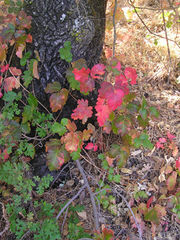Toxicodendron diversilobum
| Toxicodendron diversilobum subsp. var. | Californian poison oak, Western poison oak, Pacific Poison-oak | |||||||||||||||||||||||||||||||||||||||||||||||||||||||
|---|---|---|---|---|---|---|---|---|---|---|---|---|---|---|---|---|---|---|---|---|---|---|---|---|---|---|---|---|---|---|---|---|---|---|---|---|---|---|---|---|---|---|---|---|---|---|---|---|---|---|---|---|---|---|---|---|

|
|
| ||||||||||||||||||||||||||||||||||||||||||||||||||||||
| ||||||||||||||||||||||||||||||||||||||||||||||||||||||||
Toxicodendron diversilobum (syn. Rhus diversiloba; Western Poison-oak or Pacific Poison-oak) is a plant best known for its ability to cause allergic rashes after contact. Western Poison-oak is found only on the Pacific Coast of the United States and of Canada. It is extremely common in that region, where it is the predominant species of the genus; the closely related Atlantic Poison-oak (T. pubescens) occurs on the Atlantic Coast. The hyphenated form "Poison-oak" is used, rather than "Poison Oak" to clearly indicate that it is not a variety of oak.
Western Poison-oak is extremely variable in growth habit and leaf appearance. It grows as a dense shrub in open sunlight, or as a climbing vine in shaded areas. Like Poison ivy, it reproduces by creeping rootstocks or by seeds.[1] The leaves are divided into three leaflets, 3.5 to 10 centimeters long, with scalloped, toothed, or lobed edges- generally resembling the leaves of a true oak, though the Western Poison-oak leaves will tend to be more glossy. Leaves are typically bronze when first unfolding, bright green in the spring, yellow-green to reddish in the summer, and bright red or pink in the fall. White flowers form in the spring and, if fertilized, develop into greenish- white or tan berries. Toxicodendron diversilobum is winter deciduous, so that after cold weather sets in the stems are leafless and bear only the occasional cluster of berries. Without leaves, poison oak stems may sometimes be identified by occasional black marks where its milky sap may have oozed and dried.
Cultivation
Propagation
Pests and diseases
Varieties
Gallery
-
Green phase
-
Red phase
-
Berries
-
Pacific Poison-oak
-
Ground variation
-
Climbing variation
References
- ↑ C.Michael Hogan (2008) "Western poison-oak: Toxicodendron diversilobum", GlobalTwitcher, ed. Nicklas Strömberg
External links
- w:Toxicodendron diversilobum. Some of the material on this page may be from Wikipedia, under the Creative Commons license.
- Toxicodendron diversilobum QR Code (Size 50, 100, 200, 500)





